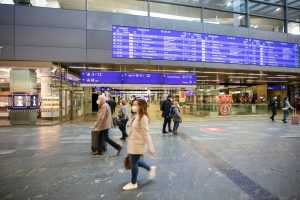 The European Commission has published an action plan to boost long-distance and cross-border passenger rail services which, combined with changes to the Trans-European Transport Network (TEN-T) and the investment from the European Investment Bank (EIB) will determine the increase of rail transport market share to meet the objectives of the EU Green Deal. At the same time, the EC also presented the proposal on the TEN-T Regulation review.
The European Commission has published an action plan to boost long-distance and cross-border passenger rail services which, combined with changes to the Trans-European Transport Network (TEN-T) and the investment from the European Investment Bank (EIB) will determine the increase of rail transport market share to meet the objectives of the EU Green Deal. At the same time, the EC also presented the proposal on the TEN-T Regulation review.
The plan, part of a package of measures for efficient and green mobility will also meet the EU’s strategic milestones of doubling high-speed rail traffic by 2030 and tripling it by 2050.
“This Action Plan will help us make rail a more attractive option for long and cross-border journeys. We have identified the main barriers, from redundant national rules to complicated ticketing and the slow uptake of digital technologies. Today we are setting out how to take down these barriers, with passengers being the real winners,” Commissioner for Transport Adina Vălean said.
To overcome the obstacles to long-distance and cross-border passenger rail services identified by the Commission, the Action Plan points the way to accelerate the digitalisation, remove the redundant national technical and operational rules, ensure a better availability of trains and bring railway staff training and certification in line with future needs. The action plan also includes the modernisation of passenger rail infrastructure and highlights the need of a more efficient use of the rail network, while ease the access to infrastructure for rail operators through appropriate pricing.
 To boost the passenger rail transport, the plan proposes more user-friendlyticketing and access to the rail system, the introduction of sustainable cross-border and/or multimodal collective transport through PSO, while making sustainable transport modes an attractive option for young people.
To boost the passenger rail transport, the plan proposes more user-friendlyticketing and access to the rail system, the introduction of sustainable cross-border and/or multimodal collective transport through PSO, while making sustainable transport modes an attractive option for young people.
According to the Commission, “most of the actions outlined in the plan must be implemented as a matter of urgency.”
The EC says that these new measures come on top of the existing EU regulatory and policy framework for rail, which equips Member States and the sector with many tools to implement the Single European Rail Area, to remove barriers and to open the market for new players and services. The full and correct implementation of the existing regulatory framework remains key, and the Commission will continue to work towards this, in cooperation with Member States and all stakeholders.
Alongside this Action Plan, the Commission unveiled a proposal to revise the Trans-European transport network (TEN-T) Regulation. Rail features prominently in the proposal, with new rules to ensure sufficient high-speed rail capacity and connections, including a minimum speed limit of 160 km/h for all passenger services using the main TEN-T rail lines, and measures to improve connections between airports and railways.
To encourage the development of the projects, the EIB has launched the “Green Rail Investment Platform” dedicated to the increase the availability of rolling stock. The finance will also support electrification, the unlocking of new business models, and the introduction of cutting-edge technologies.
Share on:



